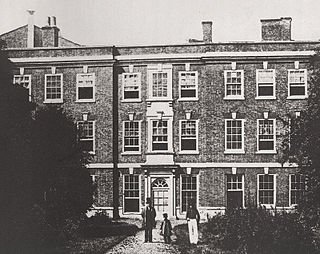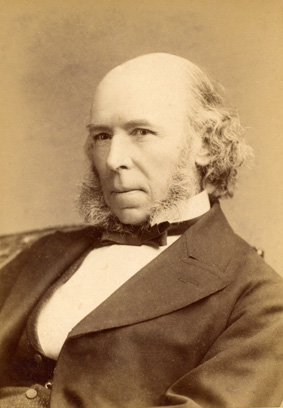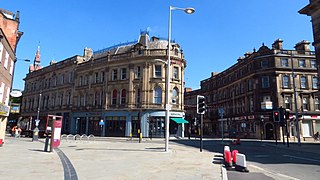
Social Darwinism is the study and implementation of various pseudoscientific theories and societal practices that purport to apply biological concepts of natural selection and survival of the fittest to sociology, economics and politics, and which were largely defined by scholars in Western Europe and North America in the 1870s. Social Darwinists believe that the strong should see their wealth and power increase while the weak should see their wealth and power decrease. Social Darwinist definitions of the strong and the weak vary, and also differ on the precise mechanisms that reward strength and punish weakness. Many such views stress competition between individuals in laissez-faire capitalism, while others, emphasizing struggle between national or racial groups, support eugenics, racism, imperialism and/or fascism.

Derwent Valley Mills is a World Heritage Site along the River Derwent in Derbyshire, England, designated in December 2001. It is administered by the Derwent Valley Mills Partnership. The modern factory, or 'mill', system was born here in the 18th century to accommodate the new technology for spinning cotton developed by Richard Arkwright. With advancements in technology, it became possible to produce cotton continuously. The system was adopted throughout the valley, and later spread so that by 1788 there were over 200 Arkwright-type mills in Britain. Arkwright's inventions and system of organising labour was exported to Europe and the United States.

The Derwent is a river in Derbyshire, England. It is 50 miles (80 km) long and is a tributary of the River Trent, which it joins south of Derby. Throughout its course, the river mostly flows through the Peak District and its foothills.
Fitness is the quantitative representation of individual reproductive success. It is also equal to the average contribution to the gene pool of the next generation, made by the same individuals of the specified genotype or phenotype. Fitness can be defined either with respect to a genotype or to a phenotype in a given environment or time. The fitness of a genotype is manifested through its phenotype, which is also affected by the developmental environment. The fitness of a given phenotype can also be different in different selective environments.

Herbert Spencer was an English polymath active as a philosopher, psychologist, biologist, sociologist, and anthropologist. Spencer originated the expression "survival of the fittest", which he coined in Principles of Biology (1864) after reading Charles Darwin's 1859 book On the Origin of Species. The term strongly suggests natural selection, yet Spencer saw evolution as extending into realms of sociology and ethics, so he also supported Lamarckism.

Matlock Bath is a village and civil parish in Derbyshire, England. It lies in the Derbyshire Dales, south of Matlock on the main A6 road, and approximately halfway between Buxton and Derby. The population of the civil parish at the 2011 census was 753. Originally built at the head of a dead-end dirt road running along the valley of the River Derwent from Matlock, the settlement developed in the 19th century as residential and a spa town which remains a tourist destination. The steep hillside restricts development with most buildings on one side of the valley and only footbridges across the river. The road was upgraded, becoming a through-way, now designated A6, avoiding the previous coaching road approach to Matlock from Cromford over very steep hills near to the Riber plateau area.

Exeter House was an early 17th-century brick-built mansion, which stood in Full Street, Derby until 1854. Named for the Earls of Exeter, whose family owned the property until 1757, the house was notable for the stay of Charles Edward Stuart during the Jacobite rising of 1745. Exeter House was replaced by offices, which in turn were replaced by Charles Herbert Aslin's Magistrates' Courts, built on the site during 1935. The courts were closed at the beginning of 2004, and after a decade vacant the building returned to use as an office development, Riverside Chambers.

"Survival of the fittest" is a phrase that originated from Darwinian evolutionary theory as a way of describing the mechanism of natural selection. The biological concept of fitness is defined as reproductive success. In Darwinian terms, the phrase is best understood as "[s]urvival of the form that in successive generations will leave most copies of itself."

Jedediah Strutt or Jedidiah Strutt – as he spelled it – was a hosier and cotton spinner from Belper, England.

Derby Museum and Art Gallery is a museum and art gallery in Derby, England. It was established in 1879, along with Derby Central Library, in a new building designed by Richard Knill Freeman and given to Derby by Michael Thomas Bass. The collection includes a gallery displaying many paintings by Joseph Wright of Derby; there is also a large display of Royal Crown Derby and other porcelain from Derby and the surrounding area. Further displays include archaeology, natural history, geology, military collections and world cultures. The Art Gallery was opened in 1882.
Social Statics, or The Conditions essential to Happiness specified, and the First of them Developed is an 1851 book by the British polymath Herbert Spencer. The book was published by John Chapman of London.

John Lombe was a silk spinner in the 18th century Derby, England.

George Sorocold was an English civil engineer of the eighteenth century notable for pioneering work on water supplies and hydraulic power systems around Great Britain.

Derby is a city and unitary authority area on the River Derwent in Derbyshire, England. The county is named after Derby, which was its original county town. As a unitary authority, Derby is administratively independent from Derbyshire County Council. The population of Derby is 261,136 (2021).

The Derby Philosophical Society was a club for gentlemen in Derby founded in 1783 by Erasmus Darwin. The club had many notable members and also offered the first institutional library in Derby that was available to some section of the public.

The Cathedral Green Footbridge is a pedestrian and cycle swing bridge in the centre of Derby, spanning the River Derwent. It forms a third side to a triangle between The Cathedral and the Silk Mill Museum.

Saint Alkmund's Way Footbridge is a replacement cycle and footbridge in Derby, England over the A601. The 2007 design includes sculptures of silk bobbins at its entrance and exit that are inspired by the nearby Silk Mill museum.

Lombe's Mill was the first successful silk throwing mill in Britain. It was built on an island on the River Derwent in Derby. It was built after John Lombe visited Piedmont in 1717 and returned to England with details of the Italian silk throwing machines – the filatoio and the torcitoio – and some Italian craftsmen. The architect was George Sorocold. At its height, the mill employed some 300 people.

A silk mill is a factory that makes silk for garments using a process called silk throwing. Traditionally, silk mills were concentrated in Japan, England, New Jersey, Pennsylvania, Italy and Switzerland.

A Prospect of Derby is a c. 1725 painting by an unknown artist that shows the layout of Derby in the early 18th century.























